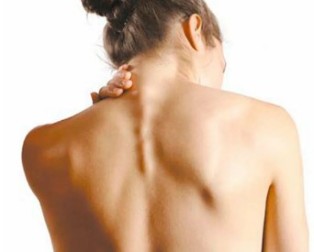Cervical osteochondrosis — disease of the intervertebral discs in the cervical spine (usually C5, C6 and C7) shall be borne by the degenerative-dystrophic character and is characterized by Proliferation of bone tissue in the neck area of the spine. The resulting osteophytes on the vertebrae (salt deposits, growths) irritate the muscles, causing their Reflex compression and increased the pressure on the vertebrae. As a result of the intervertebral discs pressed together, their strength is reduced, resulting in also contusions of the vertebral artery and the injury to the nerve, when turning the head.

For these reasons, cervical osteochondrosis is a very dangerous disease. It interferes with the blood circulation to the brain, and provokes a lack of oxygen to parts of the brain with the possible complications.
The danger of cervical degenerative disc disease
Cervical osteochondrosis — a serious disease, whose symptoms are not confined to the sensations of pain in the cervical spine can move the head. In the absence of treatment, the development of the disease, the Patient will provide you with numerous complications and can. significant symptoms to cause various functional disorders of the organism
Narrowing of the artery, which may result from the fact that the vortex is deformed and approach to the so-called spine-basilar syndrome. Insufficient supply of blood to the brain is the cause of balance disorders, dizziness, regular or permanent deterioration of vision, occurrence of Tinnitus, a semi-conscious state and loss of consciousness. Depending on the degree of the displacement of the arteries of the cervical spine and of the General characteristics of the organism can be in varying degrees of severity and combined impact.
The entrapment of occipital artery with cervical osteochondrosis is the cause of the constant headache, donations in the neck and in the head. The most dangerous is the herniation of the spinal cord and its nerve cross-rates. In this case, it can lead to serious functional disorders, the from the violation of the coordination of the extremities, reducing their sensitivity, loss of strength. Also, the Patient may have difficulties with the control of the bladder and of the intestine, often uncontrolled spas observed tables of the movements of the legs.
Without the treatment of osteochondrosis of the cervical spine leads to complications, such as spinal protrusion and hernia of the intervertebral disc of the neck. This also promotes the emergence and development of the circulatory diseases, which cause various disorders of the brain, until the death of the individual phases.
Causes of degenerative disc disease of the cervical spine
Although the traditional medicine believes that degenerative changes in the intervertebral discs of the cervical spine disease from the point of view of osteopathy — is only the Manifestation of a deeper disturbance in the body.
So, the true causes of degenerative disc of the neck disorders of the spine:
- Posture disorders. Scoliosis, Stoop, round back, kyphosis, and other malpositions, even if you carry the insignificant character, cause a severe breach in the equilibrium of the spine. As a result, the load on the intervertebral discs unequally distributed, that there is a deformation and increased wear and tear provoking. The vertebrae begin to approach, whereby the impairment of the nervous processes, developed fairly quickly a cervical osteochondrosis. Similar are the consequences of, and attitude caused by the modification of the natural condition of the edges.
- Muscle cramps. Spasmodic reaction of the muscles of the back, the chest, the Newspapers can lead to that are tense in certain areas of the body strong. In the result of Association of the position of equilibrium of the body is interrupted, whereby the change of the Position of the spine. Deformations can touch the area of the cervical spine or other parts of the spine, causing back pain, thoracic spine, cervical spine, lumbar spine.
- Disorders of blood circulation. Since the spinal discs do not receive any direct connection with the circulation and nutrition from the surrounding tissue. Blood circulation disorders of the cervical spine leads to the fact that the hard drives tissue enough fluid for rehydration (recovery of the shape due to moisture absorption), Updates of cartilage. As a result of their wear and tear is accelerated, a reduction in the spacing between the vertebrae of the cervical spine, resulting in osteochondrosis.
- Violation of Innervation. The reduction in sensitivity of the nerve roots leads to pathological changes in its structure, what remains to a displacement and deformation of the vertebral body of the cervical spine unnoticed by the patient. Because of the pain in this no disturbance in the sensibility.
- Diseases of the internal organs. Wrong Position of the internal organs, the displacement and lower due to various functional disorders leads to disruption of the overall equilibrium in the body. The result is acute effects on the Situation of the spine — cervical, lumbar vertebra is moved and deformed, causing the corresponding types of osteochondrosis.
A total of osteochondrosis of the cervical spine developed due to the impact of negative external factors, which against a natural equilibrium position of the spine and other systems of the human organism. Often, these injuries are not immediately visible, and cervical osteochondrosis progresses, leading to serious consequences. That is why it is so important to regularly osteopath, which is able to fix the causes of osteochondrosis of the cervical vertebrae and the treatment of the symptoms does not assign, as does the conventional medicine.
Signs of cervical degenerative disc disease
Depending on what eddy suggests cervical osteochondrosis the symptoms can manifest themselves in different ways. But you have, at least, is to assume, osteochondrosis of the cervical spine, so it makes sense, the salutation to a specialist to carry out a thorough examination and diagnosis. The main features of the intervertebral disc degeneration of the cervical spine:
- The pain sensations. The first Symptom is a pain that shows in the early stages, only when turning and tilting the head. Unpleasant sensations are usually spine in the right-hand or left-hand sector of the neck, sometimes the symptoms are the ceilings and the surrounding area. With the development of cervical degenerative disc pain radiating to the back of the head and frontal part of the head, the character of the migraine.
- The deterioration of the sense organs. Most vision problems begin to occur. Bright symptoms cloudiness, double vision, darkening in the eyes, wearing a regular character, there is often noise in the ears.
- Dizziness. Almost always osteochondrosis of the cervical spine is accompanied by characteristic dizziness, the when a sudden movement or turning the head, stooping, change of attitudes. This can lead to nausea and vomiting.
- Fainting. Something like a small fainting and unconsciousness is a common Symptom of advanced cervical cancer degenerative disc disease. Some patients have these symptoms can be observed and, in the case of the first development of the disease;
- Cardialgia. Together with other symptoms often there are sensations, typical for Angina pectoris;
- Feeling disorders. Depending on which vertebra is affected osteochondrosis, note on the existence of the disease is a partial loss of sensitivity in occipital and parietal areas of the head, in the area of frozen forearm. In some cases, numbness spread from the neck by Hand in the little Finger or the thumb, respectively, to the outside or on the outer side of the limbs;
- Language disorders. Is not a very common Symptom and occurs due to the loss of control over the tongue, to squeezing due to the nerve roots C3 and C4. Also in this case, there may be difficulties with breathing.
Usually the symptoms are characterized spine due to osteochondrosis of the neck, manifested itself very clearly — both individually and in combination. Therefore, they determine even. At the first signs, we recommend that you see a specialist-the osteopath for cervical osteochondrosis, symptoms and treatment — one of the areas of professional activity.

The osteopathic treatment of degenerative disc disease of the cervical spine
Today, osteopathic treatment of the osteochondrosis of the cervical spine, the most effective is. It aims at the elimination of the root causes, and not only fights the symptoms that manifest themselves in the Form of deformation and protrusion of intervertebral discs.
Faced with the osteochondrosis, the expert-the osteopath diagnosed first, the disease and its localization in the Department of the neck, that is to be determined is, which shifted the vortex and deformed. This can be used as guided by the symptoms of osteochondrosis, as well as by means of the manual examination of the patient.
The first Phase of the treatment of cervical degenerative disc disease — relief of pain. They are often the reason for this is the cervical spasms, their treatment and is carried out by the interpreter. Spazmatical reaction of the muscles of the cervical spine in response to the violation of the General balance in the body, leads to a feeling of pressure to nerve roots. In the result of pain in the cervical spine (osteochondrosis).
Often, the elimination of tension in itself is a quite effective treatment of the cervical spine. Do not remove the muscle tension, osteopath relieves only pain, but normalizes the Position of the spine. Neck part with the correct treatment position of equilibrium and out is comes.
Already after a few sessions with an osteopath a sign of cervical degenerative disc disease are minimized or disappear completely. This is due to the normalization of blood circulation, you can often prevent muscle cramps. The cervical section of the spine and the discs receive a normal diet together with blood, and, as a result of osteochondrosis of the cervical vertebrae retreats.
In the later stages of the disease, if disturbances are of a global nature and, not infrequently, other organs affect, you may need a more complex and prolonged treatment. This specialist not only osteochondrosis of the spine, but also the accompanying diseases and disorders treated, including the displacement of internal organs, lack of oxygen to the brain, injury to the transverse processes of the spinal cord, etc.
Despite the severity of the disease, osteochondrosis of the cervical-treated spinal well-enough exactly the methods of osteopathy. But is recommended for the fixing of the achieved results, as well as the prevention of complications and relapses to a specialist for other methods of physiotherapy, correction of diet, moderate exercise, massage and physiotherapy.
Depending on the degree to which pronounced, and what are the causes of osteochondrosis, treatment is customized by the professional. Depending on the outcome of the treatment can be adapted and supplemented with other processes, which helps to effectively and quickly heal osteochondrosis of the Department.
Prevention of cervical degenerative disc disease
If you spine the diagnosis "osteochondrosis of the neck", the treatment can take a very long time. To avoid too much easier to of the disease at all, leading a healthy lifestyle. You avoid the disease long and complex treatment of degenerative intervertebral disc (mostly in later stages) can be quite a simple methods of prevention.
Education of correct posture from an early age helps to avoid the treatment of osteochondrosis in adulthood. Very often, this disease in office workers suffer from, what is a sedentary lifestyle and conductive for a long time in the same Position. To avoid osteochondrosis of the spine, you should do on a regular basis, warm-up, change the Position of the body, the inclinations and the twists and turns of the head, shoulder girdle. moderate strain.
Sport, aimed at the General strengthening of the muscles, joints, bones use the skeleton significantly the probability of the occurrence of osteochondrosis of the lumbar or cervical spine.
Even if you preventive exercises help already osteochondrosis (its symptoms are pretty bright), to ease the progression of the disease. But we should not forget that you are the treatment. You should definitely take a course with a specialist osteopath. The subsequent prevention is to ensure that the signs of disc degeneration and the disease does not return.






























